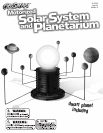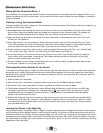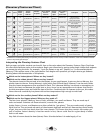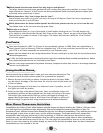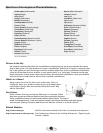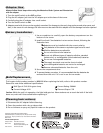
Interpreting the Planetary Features Chart
Both younger and older students can benefit from a discussion about the Planetary Features Chart. Duplicate
this chart and distribute copies to the students. Begin your discussion by posing some simple riddles that students
can answer by using the chart. For example, “I spin the fastest on my axis” (Jupiter), or “I’m the smallest planet”
(Mercury). Then explore some of the topics below. Each begins with questions you might raise to get students
thinking about the characteristics of the planets.
Which are the hottest planets? Where are they located?
Which are the coldest planets? Where are they located?
The planets closest to the sun tend to be the hottest. As you would expect, it gets very hot on Mercury, the
planet closest to the sun. During Mercury’s night (which lasts 59 Earth days), however, it can be much colder
than the lowest temperatures ever recorded on Earth. This is because Mercury has almost no atmosphere to
hold in the heat and because the night lasts so long. Venus has an atmosphere much denser than Earth’s.
Its thick atmosphere traps and holds the heat of the sun. Combined with its closeness to the sun, this makes
Venus the most consistently hot planet with surface temperatures high enough to melt lead!
Which are the four smallest planets? What are they made of?
Which are the four biggest planets? What are they made of?
The four inner planets—Mercury, Venus, Earth, and Mars—are small and dense. They are made up of
rocks and metals. Scientists call these terrestrial, or earth-like, planets.
Jupiter, Saturn, Uranus, and Neptune are often called the “gas giants.” They are made mostly of gases,
liquid, and ice. They are made up mainly of the elements hydrogen and helium. Because they consist mostly
of gas, they are much less dense than the inner planets. This means that they contain less matter per
unit of volume. Saturn’s density is less than water. In fact, Saturn could float on a giant body of either
fresh or salt water.
Very little is known about the dwarf planet, Pluto. Scientists believe it is made largely of ice.
Planetary Features Chart
Planet
Symbol
Position
relative
to sun
Average
distance
from sun
Diameter
at equator
“Year”: Period
of time to
orbit sun
Average
orbital
speed
“Day”: Time it
takes to
rotate on axis
Atmosphere Moons* Temperature
Mercury
1
st
3
5,980,000 mi
(57,900,000 km)
3
,031 mi
(4,879 km)
8
8 Earth days
3
0 mi/sec
(48 km/sec)
5
9 Earth days
almost non-existent;
t
race amounts of
hydrogen and helium
0
-
279 to 801 ºF
(-173 to 427 ºC)
Venus
2
nd
6
7,210,000 mi
(108,200,000 km)
7
,521 mi
(12,104 km)
2
24.7 Earth days
2
2 mi/sec
(35 km/sec)
2
43 Earth days
mostly carbon dioxide;
s
ulfuric acid clouds obscure
view of surface
0
9
00 ºF average
(482 ºC average)
Earth
3
rd
9
2,960,000 mi
(
149,600,000 km)
7
,926 mi
(12,756 km)
3
65.26 Earth days
1
8.5 mi/sec
(
30 km/sec)
23 hours,
56 minutes
78% nitrogen, 21% oxygen,
1
% argon, carbon dioxide,
a
nd trace gases
1
-
129 to 136 ºF
(-90 to 58 ºC)
M
ars
4
th
1
41,700,000 mi
(227,900,000 km)
4,222 mi
(
6,794 km)
1
.88 Earth years
1
5 mi/sec
(24 km/sec)
24 hours,
3
7 minutes
p
rimarily carbon dioxide 2
-185 to 50 ºF
(-140 to 20 ºC)
Jupiter
5
th
4
83,700,000 mi
(778,300,000 km)
88,846 mi
(142,980 km)
11.86 Earth years
8
mi/sec
(13 km/sec)
9
hours,
51 minutes
9
0% hydrogen
10% helium
60
average cloud
t
emperature
-
186 ºF (-121 ºC)
Saturn
6th
888,200,000 mi
(
1,429,400,000 km)
7
4,898 mi
(120,540 km)
29.42 Earth years
6 mi/sec
(
10 km/sec)
10 hours,
39 minutes
9
7% hydrogen
3% helium
33
average cloud
temperature
-
193 ºF (-125 ºC)
Uranus
7th
1,786,500,000 mi
(
2,875,000,000 km)
3
1,763 mi
(51,120 km)
83.75 Earth years
4 mi/sec
(
7 km/sec)
1
7 hours,
14 minutes
8
3% hydrogen
15% helium
2% methane
21
a
verage cloud
temperature
-
193 ºF (-125 ºC)
N
eptune
8th
2
,799,100,000 mi
(4,504,400,000 km)
30,800 mi
(
49,500 km)
164 Earth years
3
mi/sec
(5 km/sec)
1
6 hours,
7 minutes
7
4% hydrogen
25% helium
1
% methane
11
average cloud
t
emperature
-315 ºF (-193 ºC)
Pluto
D
warf
Planet
3,676,200,000 mi
(5,915,800,000 km)
1,430 mi
(
2,300 km)
248 Earth years
3 mi/sec
(5 km/sec)
6 Earth days,
9 hours,
1
8 minutes
methane gases frozen into
i
ce for most of its orbit
1
-
387 to -369 ºF
(-233 to 223 ºC)
*Scientists are constantly discovering new planetary moons and space objects. For the most up-to-date information, check one of NASA’s websites
such as: http://nssdc.gsfc.nasa.gov



